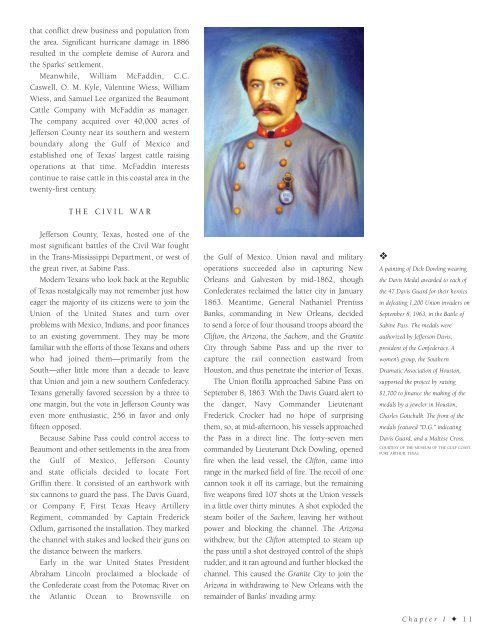Water Rails & Oil - Historic Mid & South Jefferson County
An illustrated history of the Mid and South Jefferson County area, paired with the histories of companies, families and organizations that make the region great.
An illustrated history of the Mid and South Jefferson County area, paired with the histories of companies, families and organizations that make the region great.
You also want an ePaper? Increase the reach of your titles
YUMPU automatically turns print PDFs into web optimized ePapers that Google loves.
that conflict drew business and population from<br />
the area. Significant hurricane damage in 1886<br />
resulted in the complete demise of Aurora and<br />
the Sparks’ settlement.<br />
Meanwhile, William McFaddin, C.C.<br />
Caswell, O. M. Kyle, Valentine Wiess, William<br />
Wiess, and Samuel Lee organized the Beaumont<br />
Cattle Company with McFaddin as manager.<br />
The company acquired over 40,000 acres of<br />
<strong>Jefferson</strong> <strong>County</strong> near its southern and western<br />
boundary along the Gulf of Mexico and<br />
established one of Texas’ largest cattle raising<br />
operations at that time. McFaddin interests<br />
continue to raise cattle in this coastal area in the<br />
twenty-first century.<br />
THE CIVIL WAR<br />
<strong>Jefferson</strong> <strong>County</strong>, Texas, hosted one of the<br />
most significant battles of the Civil War fought<br />
in the Trans-Mississippi Department, or west of<br />
the great river, at Sabine Pass.<br />
Modern Texans who look back at the Republic<br />
of Texas nostalgically may not remember just how<br />
eager the majority of its citizens were to join the<br />
Union of the United States and turn over<br />
problems with Mexico, Indians, and poor finances<br />
to an existing government. They may be more<br />
familiar with the efforts of those Texans and others<br />
who had joined them—primarily from the<br />
<strong>South</strong>—after little more than a decade to leave<br />
that Union and join a new southern Confederacy.<br />
Texans generally favored secession by a three to<br />
one margin, but the vote in <strong>Jefferson</strong> <strong>County</strong> was<br />
even more enthusiastic, 256 in favor and only<br />
fifteen opposed.<br />
Because Sabine Pass could control access to<br />
Beaumont and other settlements in the area from<br />
the Gulf of Mexico, <strong>Jefferson</strong> <strong>County</strong><br />
and state officials decided to locate Fort<br />
Griffin there. It consisted of an earthwork with<br />
six cannons to guard the pass. The Davis Guard,<br />
or Company F, First Texas Heavy Artillery<br />
Regiment, commanded by Captain Frederick<br />
Odlum, garrisoned the installation. They marked<br />
the channel with stakes and locked their guns on<br />
the distance between the markers.<br />
Early in the war United States President<br />
Abraham Lincoln proclaimed a blockade of<br />
the Confederate coast from the Potomac River on<br />
the Atlantic Ocean to Brownsville on<br />
the Gulf of Mexico. Union naval and military<br />
operations succeeded also in capturing New<br />
Orleans and Galveston by mid-1862, though<br />
Confederates reclaimed the latter city in January<br />
1863. Meantime, General Nathaniel Prentiss<br />
Banks, commanding in New Orleans, decided<br />
to send a force of four thousand troops aboard the<br />
Clifton, the Arizona, the Sachem, and the Granite<br />
City through Sabine Pass and up the river to<br />
capture the rail connection eastward from<br />
Houston, and thus penetrate the interior of Texas.<br />
The Union flotilla approached Sabine Pass on<br />
September 8, 1863. With the Davis Guard alert to<br />
the danger, Navy Commander Lieutenant<br />
Frederick Crocker had no hope of surprising<br />
them, so, at mid-afternoon, his vessels approached<br />
the Pass in a direct line. The forty-seven men<br />
commanded by Lieutenant Dick Dowling, opened<br />
fire when the lead vessel, the Clifton, came into<br />
range in the marked field of fire. The recoil of one<br />
cannon took it off its carriage, but the remaining<br />
five weapons fired 107 shots at the Union vessels<br />
in a little over thirty minutes. A shot exploded the<br />
steam boiler of the Sachem, leaving her without<br />
power and blocking the channel. The Arizona<br />
withdrew, but the Clifton attempted to steam up<br />
the pass until a shot destroyed control of the ship’s<br />
rudder, and it ran aground and further blocked the<br />
channel. This caused the Granite City to join the<br />
Arizona in withdrawing to New Orleans with the<br />
remainder of Banks’ invading army.<br />
❖<br />
A painting of Dick Dowling wearing<br />
the Davis Medal awarded to each of<br />
the 47 Davis Guard for their heroics<br />
in defeating 1,200 Union invaders on<br />
September 8, 1963, in the Battle of<br />
Sabine Pass. The medals were<br />
authorized by <strong>Jefferson</strong> Davis,<br />
president of the Confederacy. A<br />
women’s group, the <strong>South</strong>ern<br />
Dramatic Association of Houston,<br />
supported the project by raising<br />
$1,700 to finance the making of the<br />
medals by a jeweler in Houston,<br />
Charles Gottchalk. The front of the<br />
medals featured “D.G.” indicating<br />
Davis Guard, and a Maltese Cross.<br />
COURTESY OF THE MUSEUM OF THE GULF COAST,<br />
PORT ARTHUR, TEXAS.<br />
Chapter I ✦ 11
















